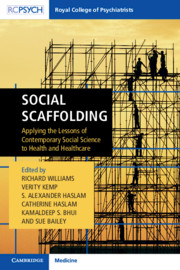Book contents
- Social Scaffolding
- Social Scaffolding
- Copyright page
- Contents
- Contributors
- Foreword
- Note
- Section 1 Schooling
- Section 2 Scoping
- Section 3 Sourcing
- Chapter 15 Crowds and Cooperation
- Chapter 16 Emergencies, Disasters and Risk Reduction: A Microcosm of Social Relationships in Communities
- Chapter 17 Shared Social Identity in Emergencies, Disasters and Conflicts
- Chapter 18 Complex Trauma and Complex Responses to Trauma in the Asylum Context
- Chapter 19 The Mental Health of Veterans: Ticking Time Bomb or Business as Usual?
- Chapter 20 Violent Radicalisation: Relational Roots and Preventive Implications
- Chapter 21 Ways Out of Intractable Conflict
- Chapter 22 Agency as a Source of Recovery and Creativity
- Section 4 Scaffolding
- Section 5 Sustaining
- Index
- References
Chapter 17 - Shared Social Identity in Emergencies, Disasters and Conflicts
from Section 3 - Sourcing
Published online by Cambridge University Press: 14 June 2019
- Social Scaffolding
- Social Scaffolding
- Copyright page
- Contents
- Contributors
- Foreword
- Note
- Section 1 Schooling
- Section 2 Scoping
- Section 3 Sourcing
- Chapter 15 Crowds and Cooperation
- Chapter 16 Emergencies, Disasters and Risk Reduction: A Microcosm of Social Relationships in Communities
- Chapter 17 Shared Social Identity in Emergencies, Disasters and Conflicts
- Chapter 18 Complex Trauma and Complex Responses to Trauma in the Asylum Context
- Chapter 19 The Mental Health of Veterans: Ticking Time Bomb or Business as Usual?
- Chapter 20 Violent Radicalisation: Relational Roots and Preventive Implications
- Chapter 21 Ways Out of Intractable Conflict
- Chapter 22 Agency as a Source of Recovery and Creativity
- Section 4 Scaffolding
- Section 5 Sustaining
- Index
- References
Summary
This chapter builds on previous chapters, on crowds (Chapter 15) and emergencies and disasters (Chapter 16), to show the relationship between the two. It describes a programme of research that has examined the extent to which shared social identity determines collective behaviour in emergencies and disasters.
We recognise that engagement and action by the public is necessary when communities and agencies in them plan for emergencies. The increased threat of major incidents, disasters and terrorist attacks means that professional responders will not always be in place in time or in sufficient number to help (Cole et al., 2011; see Chapter 16).
The social identity approach is relevant here because it explains the conditions under which crowds and groups of people can operate as psychological communities that support their members in times of danger and stress. This chapter also describes how social identity principles have been applied to understanding informal psychosocial support among some refugees of war.
- Type
- Chapter
- Information
- Social ScaffoldingApplying the Lessons of Contemporary Social Science to Health and Healthcare, pp. 154 - 164Publisher: Cambridge University PressPrint publication year: 2019
References
- 9
- Cited by

